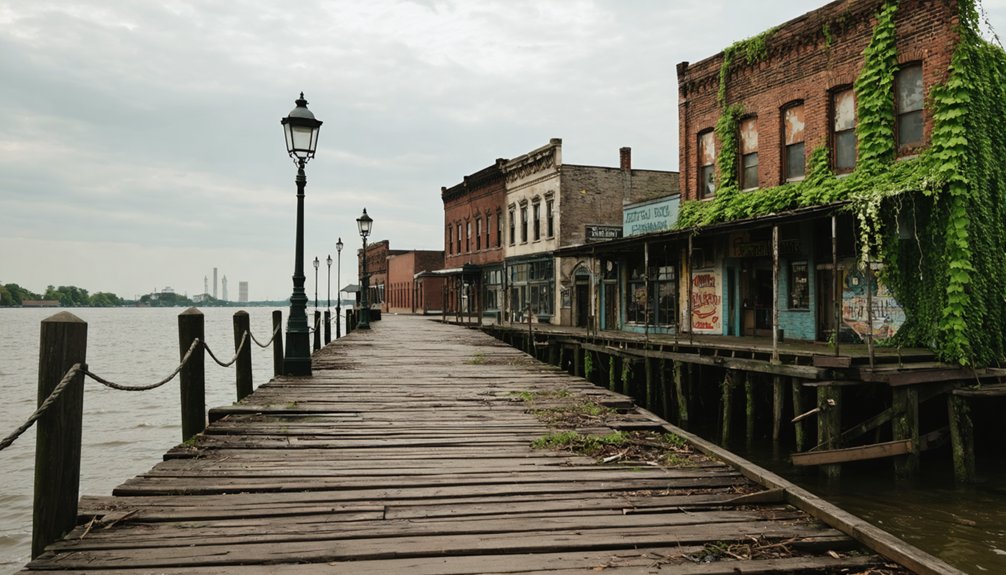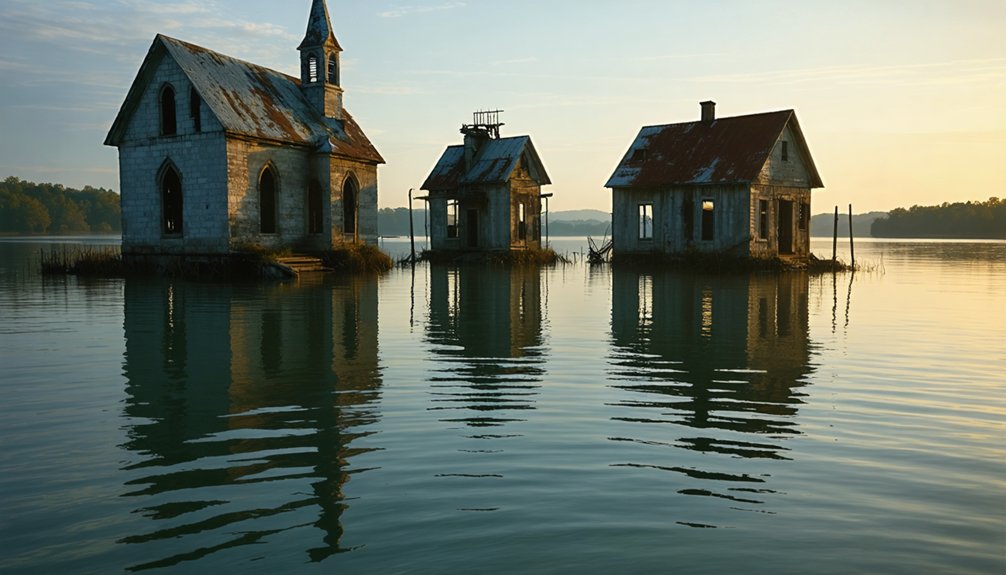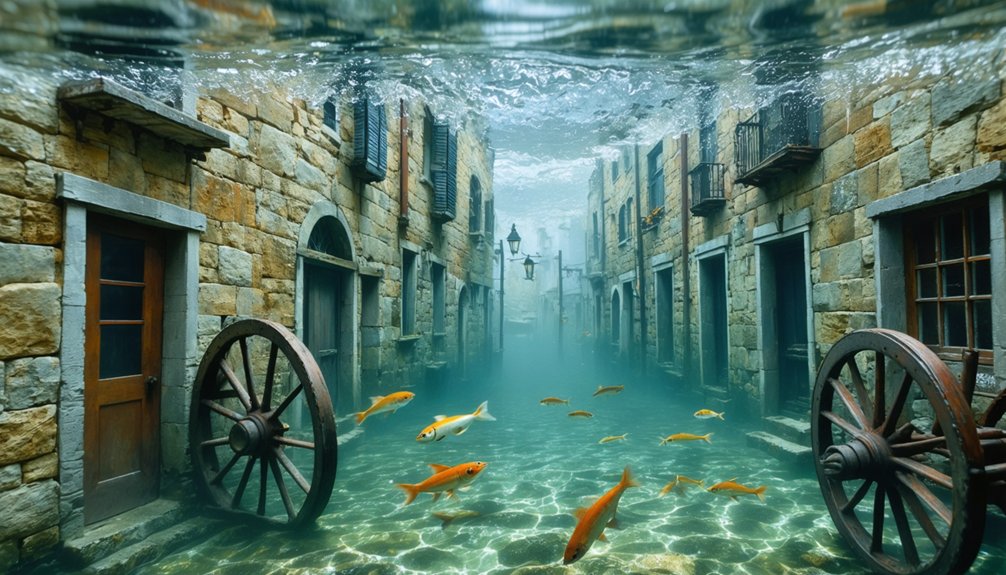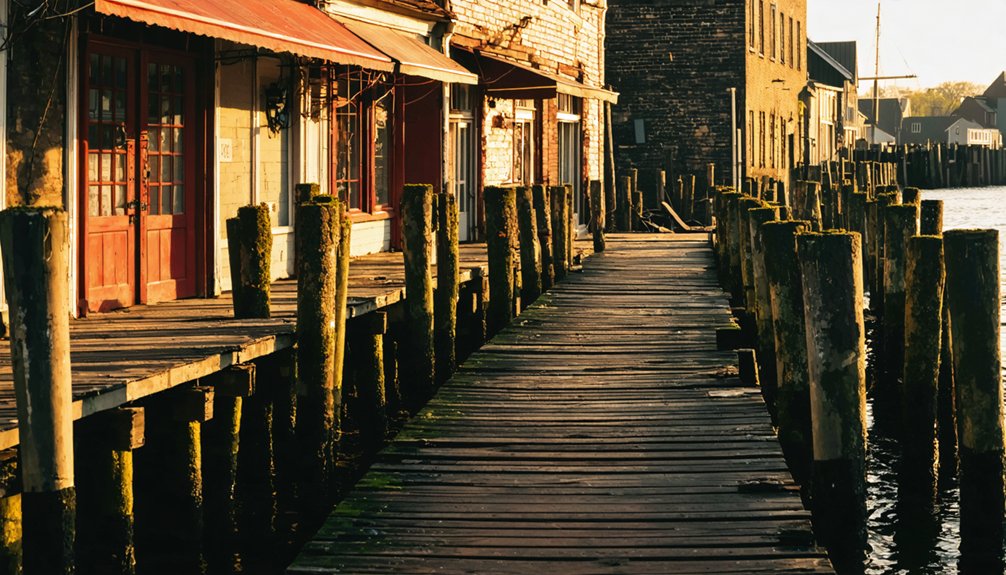America’s abandoned riverfront towns offer glimpses into a vanished era when waterways drove commerce and culture. You’ll find these forgotten settlements along the Mississippi, Missouri, and Ohio rivers, where crumbling warehouses and empty docks tell stories of boom-and-bust economies. From western mining outposts to once-thriving Midwest ports, each site reveals how railroads, natural disasters, and economic shifts transformed bustling hubs into silent monuments. These haunting locations await your exploration beyond the beaten path.
Key Takeaways
- Abandoned riverfront towns like Brownville, Yankton and Galena reveal America’s shifting economic history from water to rail transportation.
- Many ghost towns along the Mississippi and Ohio rivers feature crumbling historic architecture from the 19th century boom period.
- Natural disasters, resource depletion, and technological changes contributed significantly to the abandonment of once-thriving waterfront communities.
- Heritage tourism initiatives now preserve many waterfront ghost towns as historical attractions rather than commercial centers.
- Lesser-known sites worth exploring include Franklin (Washington), submerged towns near Conemaugh River Lake, and former mining communities along river valleys.
The Rise and Fall of America’s Historic Riverfront Settlements
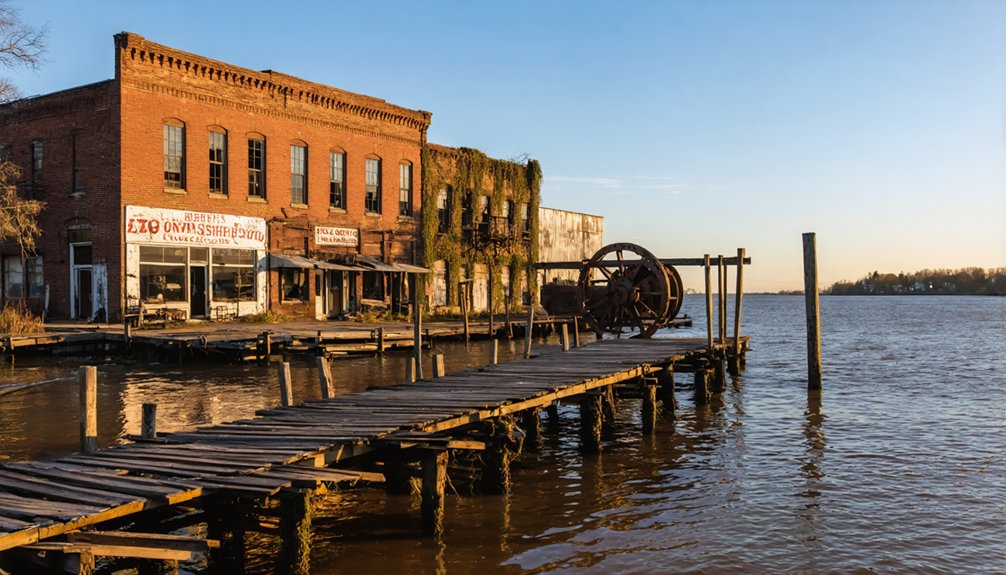
As the vast American frontier opened westward in the mid-nineteenth century, rivers became the essential arteries that nourished the growth of countless settlements along their banks.
You’ll find the remnants of this riverfront heritage in places like Brownville and Yankton, where entrepreneurs transformed fur-trading outposts into bustling commercial hubs between 1840-1860.
These towns flourished through fisheries, timber, and agriculture, serving as gateways to the frontier. Cultural transformations occurred as Indigenous peoples, Europeans, and immigrant laborers created melting pot communities.
Frontier river towns became crucibles of commerce and culture where diverse peoples forged new American identities.
The discovery of gold in regions like Colorado and Montana dramatically increased the demand for outfitting services in these river towns.
By the 1880s, however, many towns faced extinction as railroads diverted commerce inland. Natural disasters, like the Mississippi’s consumption of Kaskaskia in 1881, accelerated abandonment.
Resource depletion and changing transportation technologies ultimately silenced the once-vibrant riverfront economies that had defined America’s expansion.
Places like Galena, Illinois demonstrate how some river towns shifted from bustling centers of lead mining trade to quieter historical destinations as economic priorities changed.
Western Mining Towns: Prosperity and Abandonment Along Mountain Rivers
While the decline of riverfront trading posts and ports marked America’s eastern frontier transformation, a different pattern of rise and fall unfolded along the mountain rivers of the American West.
You’d have witnessed extraordinary mining boom communities like St. Elmo and Castle Dome sprouting almost overnight along rushing waterways in the late 19th century. These settlements throbbed with life—company stores, churches, and schools serving thousands who extracted the earth’s riches.
But prosperity proved fleeting. When ore quality diminished or mines emptied, residents departed rapidly, leaving behind more than empty buildings. Towns like Thurmond and Elkhorn City now feature empty storefronts that once bustled with commercial activity.
The environmental impact haunts these regions still—acid mine drainage turning crystal waters orange, heavy metals poisoning ecosystems, and native fish species struggling to survive. The Clark Fork River in Montana exemplifies this legacy, where a catastrophic flood in 1908 spread mining contaminants along 120 miles of riverbanks.
Today’s abandoned mining towns stand as evidence to America’s extractive relationship with its western landscapes and waterways.
Midwest Ghost Towns: Forgotten Mississippi and Ohio River Communities

The mighty Mississippi and Ohio rivers, once highways of commerce that birthed hundreds of bustling settlements across America’s heartland, now flow past the silent remains of forgotten towns that line their banks.
Rivers that once carried America’s dreams now witness only echoes of ambition along their forgotten shores.
As you explore these riverfront ghost towns, you’ll discover places like Rodney, Mississippi, abandoned by 1870 when railroads redirected commerce elsewhere. Many of these settlements were classified as small villages with populations between 200-10,000 residents before their decline.
Cairo, Illinois, strategically positioned between two great rivers, collapsed under the weight of repeated flooding, economic loss, and racial violence.
East St. Louis experienced a dramatic rise and fall, peaking in 1961 before succumbing to industrial decline.
These communities showcase a unique riverfront resilience despite their abandonment.
What remains—crumbling Baptist churches, concrete factory ruins, and empty streets—tells the story of how flooding, industrial collapse, and social upheaval transformed bustling river hubs into haunting ghost town exploration destinations.
Visitors to East St. Louis can still glimpse its former glory through abandoned landmarks like the Majestic Theatre, once home to performances by notable artists before closing in 1960 due to declining ticket sales.
The Haunting Beauty of Deserted Riverfront Architecture
You’ll find a peculiar poetry in the crumbling brick facades of these forgotten river ports, where ornate Victorian and Italianate structures stand in quiet defiance against time and nature.
The architectural remains—with their peeling paint, rusted wrought iron, and vegetation-embraced columns—tell stories of economic booms, cultural flowering, and eventual abandonment more eloquently than historical texts ever could.
These weathered sentinels along America’s waterways represent not just decay but a dignified transformation, as human ambition yields to the persistent forces of water, weather, and wilderness. Towns like Louisiana, Missouri, with their buildings from the late 1800s era, showcase the rise and decline of once-thriving communities along the Mississippi. Cairo, Illinois exemplifies this pattern, having fallen from a bustling steamboat port at the confluence of two mighty rivers to a shadow of its former self.
Crumbling Facades, Flowing Stories
Along the forgotten banks where commerce once thrived, America’s abandoned riverfront towns present a haunting tableau of architectural poetry—structures suspended between remembrance and oblivion.
You’ll find weathered storefronts still bearing faded signage, their crumbling narratives visible in layers of peeling paint and worn brick.
Each decaying sawmill and empty storefront tells a silent story of prosperity lost to changing transportation modes and economic shifts.
These architectural whispers reveal communities once dependent on steamboat traffic and river commerce, now left to nature’s reclamation. Columbus, Florida stands as testament to this decline, once bustling with steamboat services that transported thousands of cotton bales annually before its abandonment in the 1870s.
Green River, Utah exemplifies this pattern, transforming from a thriving railroad hub to a quiet town where economic decline left behind well-preserved but often vacant storefronts.
The haunting beauty of these spaces—where overgrowth embraces façades and time textures surfaces—attracts explorers seeking authentic connection to American history.
In this weathered authenticity, you’ll discover not just abandonment but the poetic intersection of human ambition and nature’s patient return.
Waterfront Decay’s Quiet Dignity
Weathered by time and neglect, America’s abandoned riverfront structures stand as dignified monuments to prosperity now passed. Their architectural features tell stories more poignant than any history book could convey.
You’ll find Victorian mansions with peeling facades alongside industrial warehouses where nature slowly reclaims dominion.
As you venture into urban exploration of these forgotten spaces, you’ll witness how evening fog transforms crumbling docks and mills into haunting silhouettes against flowing waters.
Decay aesthetics here aren’t just visual—they’re experiential. Overgrown vegetation frames weathered brickwork while water reflections dance across deteriorating foundations.
These sites balance melancholy and beauty in perfect tension, where flood-worn structures, often showing 30% vacancy rates, reveal both environmental vulnerability and enduring craftsmanship.
Each abandoned riverfront tells America’s story through its quiet dignity.
Natural Disasters That Reshaped River Town Destinies
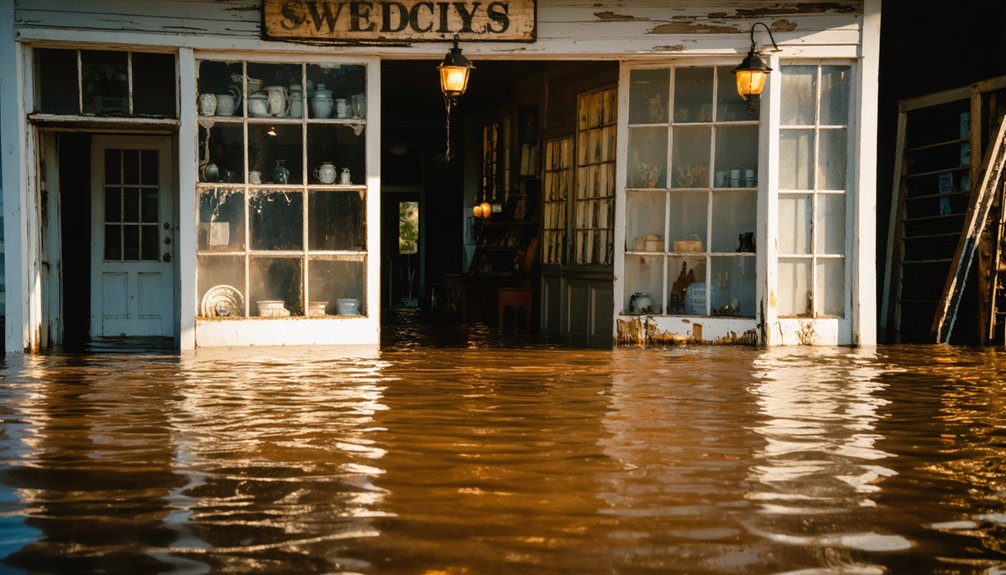
When raging waters rise or human engineering alters natural waterways, the fate of entire communities can change overnight. The Heppner Flood of 1903 claimed 247 lives, while the catastrophic Johnstown Flood of 1889 killed over 2,200 people with a 70-foot wave of destruction.
Water’s fury and humanity’s ambition have erased entire towns in mere moments, leaving only memories and markers of what once was.
You’ll find cultural resilience in communities like Old Valmeyer, Illinois, which relocated entirely after the devastating Mississippi River flood of 1993. Indigenous tribes experienced profound loss when Celilo Falls submerged beneath Dalles Dam in 1957, erasing centuries of cultural heritage despite minimal compensation.
- A lone church steeple piercing reservoir waters where a town once thrived
- Empty foundations visible only during drought years
- Ghost orchards beneath dam-created lakes, revealed when waters recede
- Stone markers commemorating submerged tribal fishing grounds
- New towns perched on hillsides, watching over their drowned predecessors below
From Bustling Ports to Silent Streets: Economic Shifts in Waterway Commerce
You’ll find the hushed streets of once-thriving river ports evidence to the transportation revolution that saw railroad networks systematically eclipse waterway shipping by the early 20th century.
When steel rails crisscrossed the continent, industrial magnates relocated factories away from flood-prone riverbanks to railway junctions, leaving waterfront communities economically adrift.
The mass exodus of manufacturing and shipping operations created a vacuum where bustling commerce once flourished, transforming vibrant river towns into hollow shells of their former prosperity.
Rail Replaced Riverboats
The transformation of America’s inland waterways from bustling commercial arteries to quiet backwaters began dramatically in the mid-20th century as rail networks systematically captured freight markets once dominated by riverboats.
You can still sense the riverboat nostalgia in these forgotten towns where transportation evolution left them behind.
Between 1950-1980, rail offered what rivers couldn’t: year-round reliability unaffected by seasonal changes, dramatically faster transit times, and direct connections to emerging markets.
- Weathered loading docks where grain elevators once filled barges now stand empty against muddy banks
- Abandoned warehouses with fading company names still visible on brick facades
- Rusting mooring cleats and bollards marking where vessels once tied up
- Empty storefronts that once housed chandleries and supply shops for river workers
- Crumbling infrastructure where freight was once transferred between modes
Industrial Centers Relocated
As rail lines carved new commercial pathways across America, they didn’t just redirect traffic—they fundamentally altered where industrial centers thrived. You can still witness this industrial migration in places like Kansas City and Omaha, which transformed from simple river posts into manufacturing powerhouses, while countless smaller river towns withered into secondary status.
Walking through these abandoned riverfronts today, you’ll find the physical remnants of this urban transformation: warehouse districts and industrial zones that once separated communities from their waterways.
By the early twentieth century, economic restructuring forced manufacturers to relocate and railroad operations to shut down. Immigrant-built communities—from Irish canal workers in Kingston to French-Canadian textile workers in the Blackstone Valley—lost their economic foundations when industries departed.
Periodic flooding and market shifts only accelerated the abandonment, leaving behind the silent, vacant waterfronts you’ll encounter in these forgotten towns.
Preserving America’s Waterfront Heritage Through Tourism
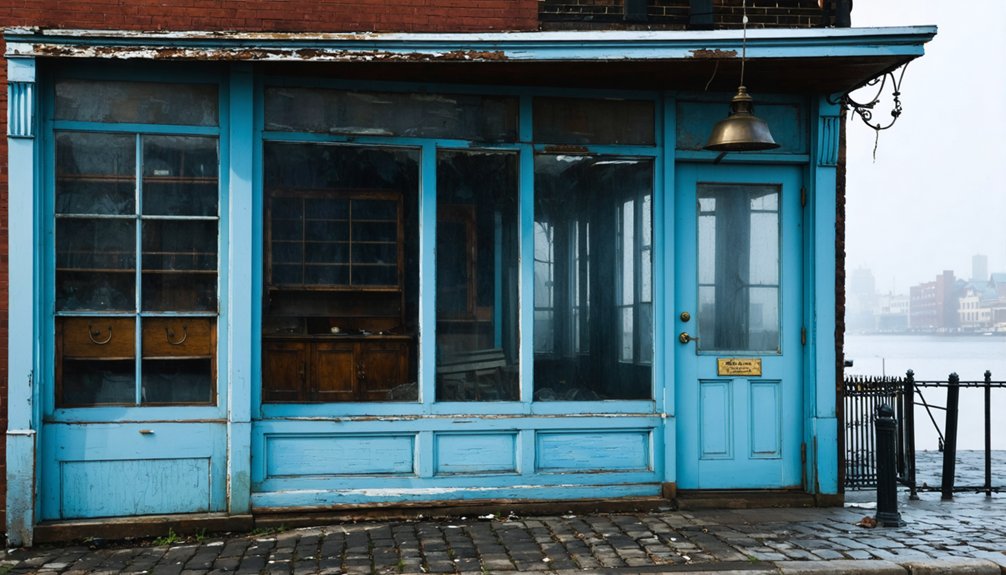
Countless abandoned riverfront towns across America are finding new life through strategic heritage tourism initiatives, transforming neglected waterfronts into vibrant destinations that honor their historical significance.
The Great American Outdoors Act and National Park Service funding have injected billions into waterfront revitalization projects, while heritage tourism—now a $128 billion market—creates economic opportunities through cultural heritage preservation.
You’ll discover communities embracing their authentic past rather than commercializing it, with programs like the Texas Heritage Trails boosting visitor spending by 14% and creating thousands of jobs nationwide.
- Historic mills transformed into interactive museums where water wheels still turn
- Wooden boardwalks lined with artisan shops housed in restored 19th-century buildings
- Traditional fishing boats offering guided heritage tours along once-industrial canals
- Native American cultural centers hosting powwows on ancestral riverfront grounds
- Former warehouses converted to waterfront restaurants serving regional cuisine
Hidden Gems: Lesser-Known Abandoned River Towns Worth Exploring
You’ll find America’s forgotten riverfront legacy in places like Franklin, Washington, where abandoned coal mining structures stand as silent witnesses to the boom-and-bust cycle along the Green River Gorge.
The Mississippi River Basin Model in Jackson offers a sprawling 200-acre monument to mid-century engineering ingenuity, now reclaimed by nature but retaining its architectural integrity.
Beneath Pennsylvania’s Conemaugh River Lake lie 14 submerged ghost towns including Livermore and Social Hall, occasionally revealed when water levels recede, providing rare glimpses into communities intentionally sacrificed for flood control.
Hidden River Mining Towns
While sprawling metropolises along America’s major waterways often dominate historical narratives, the forgotten coal towns nestled in river gorges tell equally compelling stories of boom-and-bust economies.
These hidden histories reveal America’s mining legacies through places like Nuttallburg and Caperton in West Virginia’s New River Gorge, where nature has reclaimed what industry abandoned after World War II.
- Coal dust still seems to hang in the air as you walk among Nuttallburg’s preserved ruins.
- At Blue Heron, steel “ghost structures” let you hear the voices of those who once called it home.
- Beneath Centralia, Pennsylvania, fires still burn decades after residents fled.
- Sealed mine portals whisper of the dangerous work that built these communities.
- Railroad tracks, now silent, once carried the lifeblood of these river-bound economies.
River Ports Frozen Time
Beyond the well-documented decline of major American ports, a constellation of smaller riverfront communities sits suspended in time, offering explorers an intimate glimpse into our nation’s maritime past.
Visit Savannah’s Franklin Street, where riverfront nostalgia permeates abandoned buildings that once bustled with commerce before steamships relocated elsewhere. By the 1970s, this historic waterfront had dwindled to just four shops and mostly vacant lots.
In Mobile, you’ll find infrastructure trapped between Civil War devastation and the economic transformation wrought by expanding railroads.
Don’t miss the Delaware River’s “Dead Fleet,” where vessels like the Marie F. Cummins dropped anchor in 1921 and never sailed again.
These forgotten ports—victims of transportation shifts, industrial decay, and natural disasters—offer authentic windows into America’s complex relationship with waterways that once defined our commercial identity.
Flooded Communities Preserved
Beneath the still waters of America’s vast reservoir system lies a hidden America—entire communities frozen in time when rising waters claimed their streets, homes, and histories.
These flooded heritage sites from the dam-building era of the 1920s-1970s tell stories of sacrifice for progress. You’ll find Loyston, Tennessee and Andersonville, South Carolina among dozens of towns deliberately erased for hydroelectric power and flood control.
- Norris Dam’s rising waters swallowed Loyston’s trading posts and family homes in 1935
- Cemetery islands emerge in Fontana Lake when water levels drop, revealing Proctor’s submerged memories
- Four Massachusetts towns—Dana, Prescott, Greenwich, and Enfield—simultaneously disincorporated on April 28, 1938
- Elbowoods’ tribal fishing grounds vanished beneath reservoir waters, altering centuries-old traditions
- Drought conditions occasionally reveal St. Thomas’ foundations, briefly exposing what progress submerged
Life After Abandonment: How Former River Towns Reinvent Themselves
When a riverfront town faces abandonment, the silence of empty streets and shuttered businesses doesn’t necessarily signal its final chapter. Across America, former river towns are rewriting their stories through innovative rebirth strategies.
In places like Lock Haven, Pennsylvania, community engagement drives revitalization through historic restoration and educational partnerships that foster small business development.
Meanwhile, environmental remediation transforms contaminated mining towns like Eureka, Colorado, creating foundations for economic redevelopment.
From toxic legacy to opportunity, environmental cleanup provides riverfront mining towns a blank canvas for economic reinvention.
You’ll find creative approaches everywhere: Chicago’s Wild Mile converts degraded waterways into floating eco-parks, while Arizona’s route towns harness nostalgia tourism to breathe life into abandoned downtowns.
These renaissance stories share common threads—leveraging unique heritage, involving residents in planning, and reimagining natural assets.
Where industry once defined these communities, adaptive reuse and ecological restoration now shape their promising futures.
Photography and Exploration Tips for Riverfront Ghost Towns
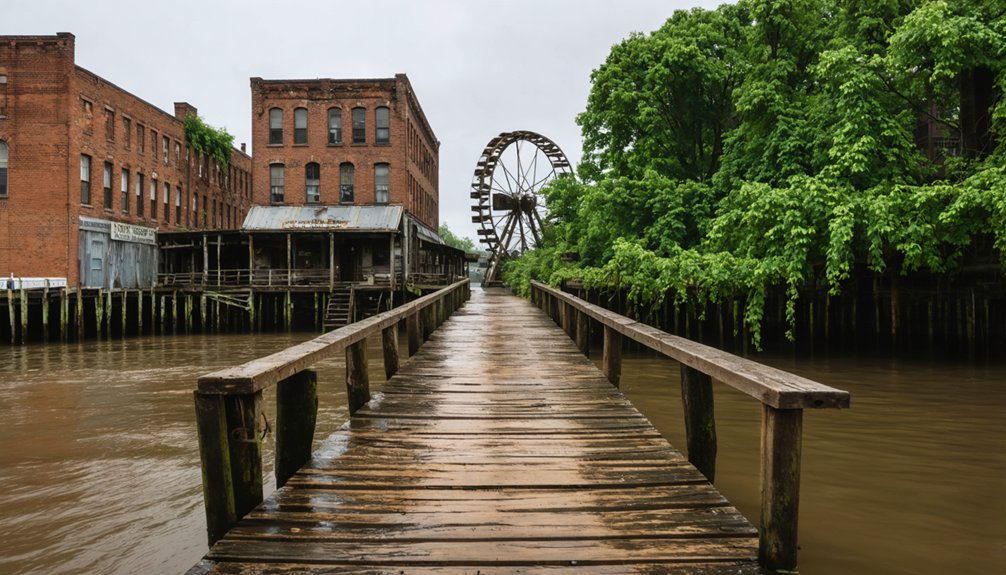
The haunting allure of abandoned riverfront towns offers photographers and explorers a unique window into America’s forgotten waterway heritage.
When planning your ghost town photography adventure, research thoroughly using historical maps and online resources, while respecting exploration ethics by obtaining permissions and leaving no trace.
- Capture dawn light filtering through collapsed docks where steamboats once moored
- Frame your shots through broken windows that once watched river traffic flow
- Document weathered storefronts where river merchants counted their daily earnings
- Contrast rusted machinery against the flowing water that once powered bustling industry
- Photograph nature’s reclamation as vines embrace abandoned riverside warehouses
Always prioritize safety by inspecting structures before entering, wearing protective gear, and informing others of your itinerary.
Frequently Asked Questions
Are Abandoned Riverfront Towns Legally Accessible to Visitors?
Many abandoned riverfront towns are legally accessible, though your access rights vary by ownership. You’ll face fewer legal liabilities on public lands, while private properties require explicit permission before exploring.
What Paranormal Activities Have Been Reported in These Ghost Towns?
Hushed whispers follow you through abandoned riverfront towns. You’ll encounter shadowy figures, mysterious orbs, and unexplained voices—ghost sightings that embody America’s dark urban legends and forgotten tragedies along our waterways.
How Have Climate Change Impacts Affected Preservation Efforts?
You’ll face preservation challenges as rising temperatures drain the Colorado River and extreme weather erodes historic foundations. Climate adaptation requires embracing indigenous knowledge while battling ecosystem degradation that threatens your riverfront heritage’s economic viability.
Which Riverfront Ghost Towns Allow Overnight Camping or Accommodations?
You’ll find camping regulations permit overnight stays at Cairo, Terlingua, and Rodney with varying accommodation options from primitive tent sites to nearby RV parks with full hookups.
What Wildlife Hazards Exist When Exploring Abandoned River Settlements?
Walking on eggshells won’t protect you from wildlife encounters with mercury-poisoned fish, lead-contaminated mammals, and asbestos-breathing birds. Take safety precautions against toxic water, disease-carrying mosquitoes, and unstable structures these creatures inhabit.
References
- https://www.geotab.com/ghost-towns/
- https://whakestudios.com/us-ghost-towns/
- https://backroadplanet.com/10-river-towns-with-rich-histories/
- https://www.youtube.com/watch?v=ffzJ2lHljl8
- https://www.atlasobscura.com/lists/americas-best-preserved-ghost-towns
- https://en.wikipedia.org/wiki/Lists_of_ghost_towns_in_the_United_States
- https://momanditoday.com/americas-most-underrated-river-cities-hidden-gems-along-americas-waterways/
- https://plainshumanities.unl.edu/encyclopedia/doc/egp.ct.043.html
- https://www.nwcouncil.org/reports/columbia-river-history/chronology/
- https://en.wikipedia.org/wiki/Timeline_of_the_American_Old_West
